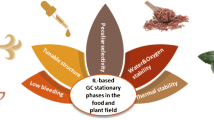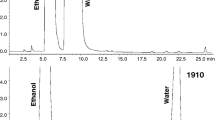Abstract
This study investigates applications and performance evaluation of SLB-IL60, SLB-IL76 and SLB-IL111 columns, in relation to a DB-Wax column, for the analysis of coffee volatile compounds. Both standards and an authentic coffee sample were analysed, with solid-phase microextraction (SPME) sampling of the latter. A cryofocusing method was applied to improve resolution of the earliest eluting peaks using splitless injection SPME sample analysis. The Grob test was used to verify the inertness and efficiency of the columns, helping to understand the interactions between analytes and stationary phases, particularly toward more polar coffee analytes. A DB-5 column was used only in analysis of n-alkanes and Grob test mixtures as an apolar reference. The evaluated ionic liquid columns showed a moderate acid-base character and low inertness for compounds with hydrogen bond capabilities, especially for the hydroxylated analytes, 2,3-butanediol in the Grob test, and furanones and acids in the coffee standards. The columns exhibiting the best resolution and efficiency were DB-Wax and SLB-IL60, both for samples and standards. Although the DB-Wax column is preferred for analysis of coffee volatiles, due to better inertness, the evaluated ionic liquid columns allowed identification of compounds that were not observed in separations with the Wax-phase column in this work. Among these compounds is 3,4-dimethyl-2,5-furandione, seldom reported in the literature of coffee. Proposed improvement by the manufacturer in the inertness of the columns evaluated in this study may lead to better results; so future versions of IL phases may be better applied in the separation of target analytes, especially those with basic character.

Illustrative representation of the sample (coffee) and the chemical structures of the stationary phases of the ionic liquid capillary columns used as object of study in the present work.





Similar content being viewed by others
References
Poole CF, Lenca N. Gas chromatography on wall-coated open-tubular columns with ionic liquid stationary phases. J Chromatogr A. 2014;1357:87–109.
Hantao LW, Toledo BR, Augusto F. Fases estacionárias de líquidos iônicos em cromatografia gasosa: fundamentos, avanços recentes e perspectivas. Quim Nova. 2016;39:81–93.
Zeng AX, Chin ST, Nolvachai Y, Kulsing C, Sidisky LM, Marriott PJ. Characterisation of capillary ionic liquid columns for gas chromatography-mass spectrometry analysis of fatty acid methyl esters. Anal Chim Acta. 2013;803:166–73.
Kulsing C, Nolvachai Y, Zeng AX, Chin ST, Mitrevsky B, Marriott PJ. From molecular structures of ionic liquids to predicted retention of fatty acid methyl esters in comprehensive two-dimensional gas chromatography. ChemPlusChem. 2014;79:790–7.
Nolvachai Y, Kulsing C, Marriott PJ. Thermally sensitive behavior explanation for unusual orthogonality observed in comprehensive two-dimensional gas chromatography comprising a single ionic liquid stationary phase. Anal Chem. 2015;87:538–44.
Nolvachai Y, Kulsing C, Marriott PJ. In silico modeling of hundred thousand experiments for effective selection of ionic liquid phase combinations in comprehensive two-dimensional gas chromatography. Anal Chem. 2016;88:2125–31.
Ragonese C, Sciarrone D, Tranchida PQ, Dugo P, Dugo G, Mondello L. Evaluation of a medium-polarity ionic liquid stationary phase in the analysis of flavor and fragrance compounds. Anal Chem. 2011;83:7947–54.
Ragonese C, Sciarrone D, Tranchida PQ, Dugo P, Mondello L. Use of ionic liquids as stationary phases in hyphenated gas chromatography techniques. J Chromatogr A. 2012;1255:130–44.
Cagliero C, Bicchi C, Cordero C, Liberto E, Sgorbini B, Rubiolo P. Room temperature ionic liquids: new GC stationary phases with a novel selectivity for flavor and fragrance analyses. J Chromatogr A. 2012;1268:130–8.
Cagliero C, Bicchi C, Cordero C, Liberto E, Rubiolo P, Sgorbini B. Analysis of essential oils and fragrances with a new generation of highly inert gas chromatographic columns coated with ionic liquids. J Chromatogr A. 2017;1495:64–75.
Sun P, Armstrong DW. Ionic liquids in analytical chemistry. Anal Chim Acta. 2010;661:1–16.
Cordero C, Bicchi C, Rubiolo P. Group-type and fingerprint analysis of roasted food matrices (coffee and hazelnut samples) by comprehensive two-dimensional gas chromatography. J Agric Food Chem. 2008;56:7655–66.
Arruda NP, Hovell AMC, Rezende CM, Freitas SP, Couri S, Bizzo HR. Discriminação entre estádios de maturação e tipos de processamento de pós-colheita de cafés arábica por microextração em fase sólida e análise de componentes principais. Quim Nova. 2011;34:819–24.
Sunaharun WB, Williams DJ, Smyth HE. Complexity of coffee flavor: a compositional and sensory perspective. Food Res Int. 2014;62:315–25.
Grob K Jr, Grob G, Grob K. Comprehensive, standardized quality test for glass capillary columns. J Chromatogr. 1978;156:1–20.
Grob K, Grob G, Grob K Jr. Testing capillary gas chromatographic columns. J Chromatogr. 1981;219:13–20.
van den Dool H, Kratz PD. A generalization of the retention index system including linear temperature programmed gas—liquid partition chromatography. J Chromatogr. 1963;11:463–71.
Bieri S, Marriott PJ. Dual-injection system with multiple injections for determining bidimensional retention indexes in comprehensive two-dimensional gas chromatography. Anal Chem. 2008;80:760–8.
Perera RMM, Marriott PJ, Galbally IE. Headspace solid-phase microextraction—comprehensive two-dimensional gas chromatography of wound induced plant volatile organic compound emissions. Analyst. 2002;127:1601–7.
Rodríguez-Sánchez S, Galindo-Iranzo P, Soria AC, Sanz ML, Quintanilla-López JE, Lebrón-Aguilar R. Characterization by the solvation parameter model of the retention properties of commercial ionic liquid columns for gas chromatography. J Chromatogr A. 2014;1326:96–102.
Weber W, Andersson JT. Ionic liquids as stationary phases in gas chromatography-an LSER investigation of six commercial phases and some applications. Anal Bioanal Chem. 2014;406:5347–58.
Cardoso JN, Neto FRA. Testes de avaliação de colunas capilares para cromatografia com fase gasosa de alta resolução. Quim Nova. 1986;9:58–63.
Anderson JL, Armstrong DW. High-stability ionic liquids. A new class of stationary phases for gas chromatography. Anal Chem. 2003;75:4851–8.
Budryn G, Nebesny E, Kula J, Majda T, Krysiak W. HS-SPME/GC/MS profiles of convectively and microwave roasted Ivory Coast Robusta coffee brews. Czech J Food Sci. 2011;29:151–60.
Cheong MW, Tong KH, Ong JJM, Liu SQ, Curran P, Yu B. Volatile composition and antioxidant capacity of Arabica coffee. Food Res Int. 2013;51:388–96.
Lee LW, Cheong MW, Curran P, Yu B, Liu SQ. Modulation of coffee aroma via the fermentation of green coffee beans with Rhizopus oligosporus: II. Effects of different roast levels. Food Chem. 2016;211:925–36.
Sasaki Y, Shibamoto T, Wei CI, Fernando S. Biological and chemical studies on overheated brewed coffee. Food Chem Toxicol. 1987;25:225–8.
Toci AT, Farah A. Volatile compounds as potential defective coffee beans’ markers. Food Chem. 2008;108:1133–41.
Lee C, Lee Y, Lee JG, Buglass AJ. Development of a simultaneous multiple solid-phase microextraction-single shot-gas chromatography/mass spectrometry method and application to aroma profile analysis of commercial coffee. J Chromatogr A. 2013;1295:24–41.
Nagasawa A, Kamada Y, Kosaka Y, Arakida N, Hori M. Catechol—an oviposition stimulant for cigarette beetle in roasted coffee beans. J Chem Ecol. 2014;40:452–7.
Lee C, Lee Y, Lee JG, Buglass AJ. Improving the extraction of headspace volatile compounds: development of a headspace multi-temperature solid-phase micro-extraction-single shot-gas chromatography/mass spectrometry (mT-HSSPME-ss-GC/MS) method and application to characterization of ground coffee aroma. Anal Methods. 2015;7:3521–36.
Ryan D, Shellie R, Tranchida P, Casilli A, Mondello L, Marriott P. Analysis of roasted coffee bean volatiles by using comprehensive two-dimensional gas chromatography-time-of-flight mass spectrometry. J Chromatogr A. 2004;1054:57–65.
Acknowledgments
The authors thank collaborating researchers from Universidade Federal do Rio de Janeiro (UFRJ) and Embrapa Agroindústria de Alimentos who assisted with this study. We also thank the financial support of Brazilian agencies Coordenação de Aperfeiçoamento de Pessoal de Nível Superior (CAPES), Conselho Nacional de Desenvolvimento Científico e Tecnológico (CNPq) and Fundação Carlos Chagas Filho de Amparo à Pesquisa do Estado do Rio de Janeiro (FAPERJ).
Author information
Authors and Affiliations
Corresponding authors
Ethics declarations
Conflict of interest
The authors declare that they have no conflicts of interest.
Additional information
Published in the topical collection Ionic Liquids as Tunable Materials in (Bio)Analytical Chemistry with guest editors Jared L. Anderson and Kevin D. Clark.
Electronic supplementary material
ESM 1
(PDF 171 kb)
Rights and permissions
About this article
Cite this article
Amaral, M.S.S., Marriott, P.J., Bizzo, H.R. et al. Ionic liquid capillary columns for analysis of multi-component volatiles by gas chromatography-mass spectrometry: performance, selectivity, activity and retention indices. Anal Bioanal Chem 410, 4615–4632 (2018). https://doi.org/10.1007/s00216-017-0718-7
Received:
Revised:
Accepted:
Published:
Issue Date:
DOI: https://doi.org/10.1007/s00216-017-0718-7




